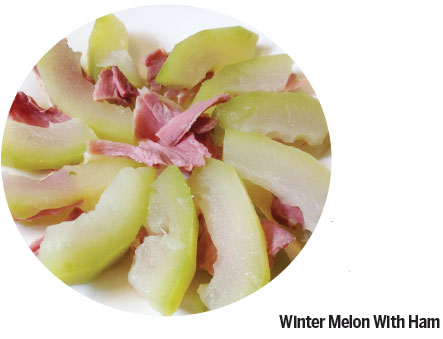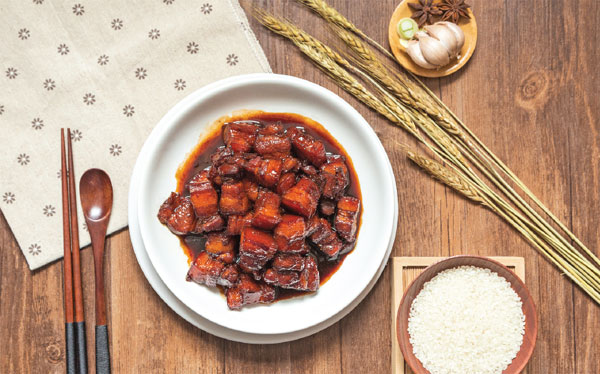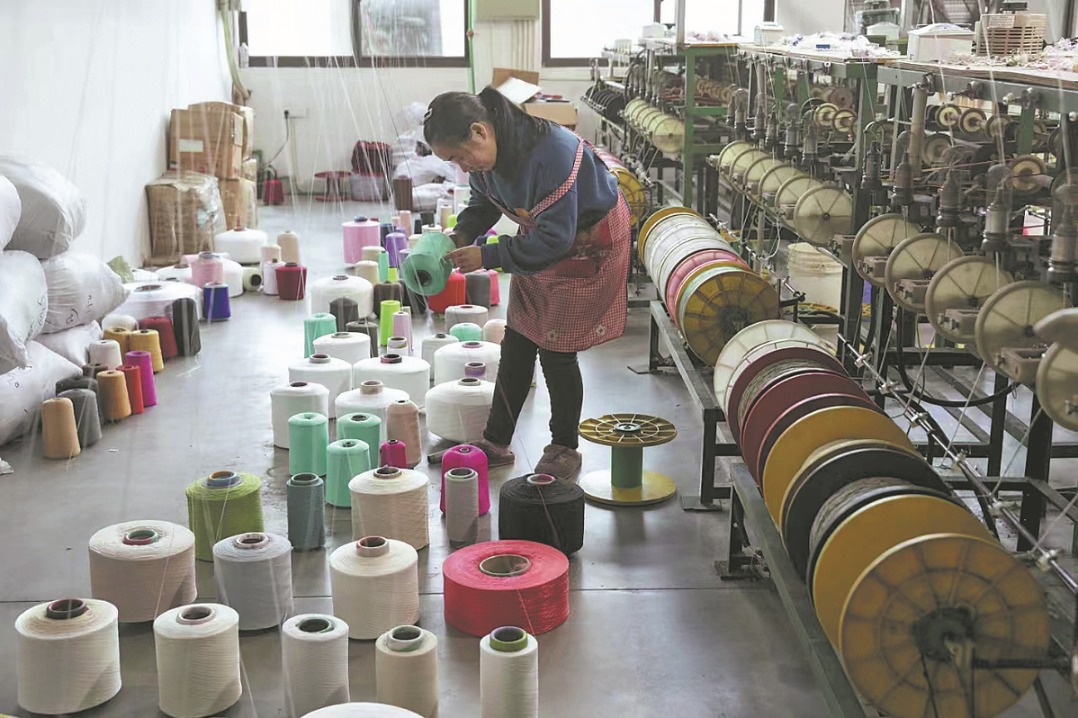Grandmother's kitchen classics

Editor's Note: China is divided into as many culinary regions as there are different ethnic groups. Its geographical diversity and kaleidoscopic cultural profiles contribute to the unending banquet of flavors.
My husband's palate was shaped by his maternal grandmother's cooking. She was from Shaoxing, a famous city in Zhejiang province.
Because her husband's career took him to Beijing and Tianjin, this petite lady with tiny bound feet spent three-quarters of her life in the unfamiliar north and assuaged her homesickness by cooking the food of home.
So it was that my spouse and his siblings spent their childhood eating dishes that their hutong friends had never even heard of.
| Hongshaorou gleams with a delectable sheen. Nainai's version used Shaoxing wine and blended spices. Provided to China Daily and (below) Cang Lide / For China Daily |
Nainai was an excellent cook, with an eye for detail that made every dish from her kitchen memorable. Her first priority was always her husband, and the best morsels were reserved for him before the large extended family of children and grandchildren were fed.
Even in the difficult years of famine and hardship in the last years of the 1950s, the old lady somehow managed to make even steamed Chinese cabbage interesting.
In better times, the family enjoyed her kitchen talents and a creativity that developed precisely because she was so far from home.
She made her own steamed breads and buns because rice was precious and wheat flour was cheaper and easily available. And when there were leftover mantou, she carefully saved them to make dajiang, the sweet paste that can be used as seasoning.
She also made meidouzi, a fermented soybean relish seasoned with ginger. It was salty and sweet and went down with rice very well.
Decades later, my husband and his sisters are still hunting for that elusive taste. There are a few dishes that they associate with Nainai.
The first is a pond crucian carp or jiyu that is braised in a sweet and sour sauce. This little fish is full of bones and normally difficult to eat. But Nainai worked her magic.
First, she seared whole sprigs of spring onions until they were fragrant. Then she layered the little carps on top, followed by more spring onions. The next to go in was a bowl of soy sauce, sugar and Zhejiang black vinegar flavored with a piece of cinnamon and a couple of star anise pods.
The spices would get rid of the earthiness of the freshwater fish.
Then the whole claypot was slowly simmered until the spring onions melted into the sauce and the fish bones became softened by the vinegar. It was a dish that tasted even better overnight.
Another specialty was her red-cooked pork, the ubiquitous hongshaorou. Nainai's version gleamed with a delicious sheen and was scented with Shaoxing wine and a secret blend of spices.
My husband is not fond of aubergines, or eggplant, but he taught me a recipe that he says his grandmother made. This is a stuffed aubergine that is steamed.
The big round eggplant is cut like an accordion, but the slices are left connected. Minced pork, diced Jinhua ham and chopped pickled rutabaga are thoroughly mixed and stuffed between the aubergine slices. Chopped tomatoes are then spooned over it, and the whole platter is steamed until the aubergine is totally soft. Then the dish is finished with a scattering of fresh coriander leaves.
When you apply today's food logic, this is a brilliant dish.
Aubergines need plenty of oil to make them palatable, but this dish uses a frugal combination of minced meat and ham to season and flavor the otherwise bland vegetable without additional oil. The addition of chopped tomatoes adds another layer of umami.
The aubergine acts like a sponge that absorbs all the flavors in this healthy and delicious creation. Nainai also cured her own meats in memory of the sauce-scented pork hocks that her hometown was so famous for.
My husband remembers squatting next to a frying pan over a charcoal fire slowly roasting salt and Sichuan peppercorns. This was the pickling mix.
"Keep the fire low and keep stirring everything until you hear the peppercorns and salt pop," Nainai told him.
And after he obediently completed his task, Nainai would allow the mixture to cool completely before rubbing it all over the boned pork hock.
The salted hock would be tied securely with thread and placed in an earthenware crock and allowed to dry out. After the water totally evaporated, it would be strung up in the cold northern winds to cure.
When the Spring Festival came around, slices of the salted pork would go into a delicious soup with bamboo shoots, fresh belly pork, knotted tofu skins and sweet cabbage.
Grandmother had a wide repertoire of recipes, many based on the familiar dishes she ate as a girl in her southern homeland. But living in Beijing, she adapted them using the more common ingredients in the north. And in so doing, she created a fusion of tastes that became unique to her family.
paulined@chinadaily.com.cn
Nainai's recipes
Carp in Vinegar Sauce
4-6 small crucian carp, or jiyu
300g spring onions
2-3 thin slices ginger
1/2 cup soy sauce
1/2 cup Zhejiang black vinegar
4 tablespoons crushed rock sugar
1 small stick cinnamon
1-2 pods star anise
Clean and gut the carp, removing the black membrane lining the stomach. Wash and pat dry.
Heat up oil and add ginger slices. Add fish and fry till golden brown on all sides.
Remove excess oil, then add whole spring onions to the bottom of the pan. Layer the fried carp on top and add more spring onions.
Add the soy sauce, vinegar, rock sugar, cinnamon and star anise. Keep simmering for another 30 to 35 minutes.
This dish is delicious kept overnight, when the vinegar literally pickles the fish until the bones melt and they can be eaten without fear.
Steamed Whole Aubergine
1 big round aubergine (eggplant), about 400g
200g minced pork
1 teaspoon cornstarch
2-3 slices Chinese ham, finely minced
2-3 slices Sichuan pickled vegetable, diced
2 dried Chinese mushrooms, soaked and diced
2 whole tomatoes, diced
Coriander leaves for garnish
Prepare the stuffing. Mix the ground pork, minced ham, Sichuan pickles and dried mushrooms together. Add cornstarch. Add salt sparingly, since the ham is salty enough.
Next, place the aubergine between two chopsticks and make vertical cuts down the vegetable, but leave the bottom connected.
Stuff the filling between the slices. Press the aubergine so that the slices stick together.
Place the stuffed eggplant in a dish deep enough to catch the juices. Spoon the diced tomatoes over. Steam over high heat for 30 to 45 minutes or until a chopstick goes through the aubergine without any resistance.
Remove from heat and sprinkle some sesame oil over. Garnish with coriander leaves.
Winter Melon With Ham
500g winter melon
150g Chinese ham, thinly sliced
This is a very simple but delicious way to eat winter melon, which some regard as very bland. You can also use pumpkin for this dish.
Peel and seed the winter melon and cut into 1 cm thick slices.
Alternate slices of winter melon and ham on a deep dish. Steam over high heat for 30 minutes until the melon turns transparent. You don't need to add any salt to this dish, but a sprinkling of black pepper will make it taste even better.

(China Daily Africa Weekly 10/20/2017 page19)
Today's Top News
- EU has much to learn from China-Global South ties
- Xi holds phone conversation with Merz
- Xi stresses high-quality cultural-ethical advancement
- Trump halts Harvard's intl student enrollment
- Xi's visit gives impetus to our work
- Financing support enhanced for micro, small companies































